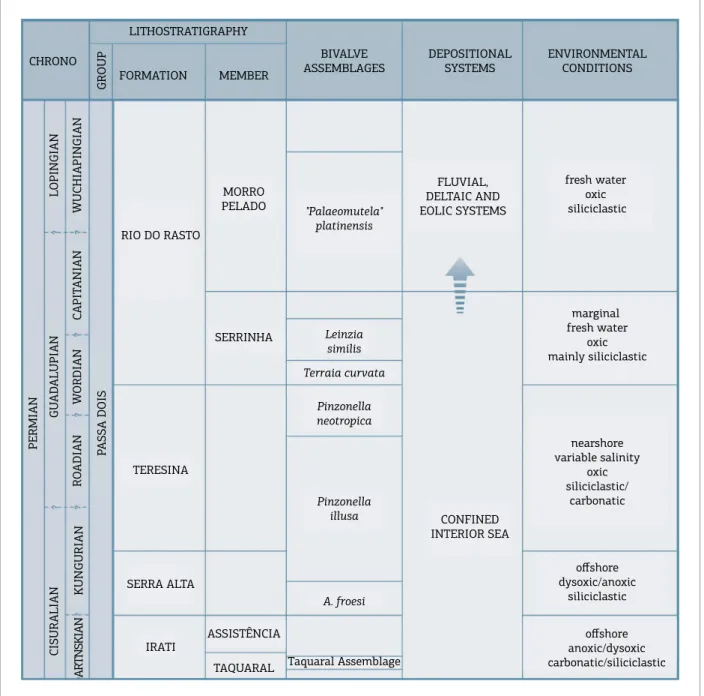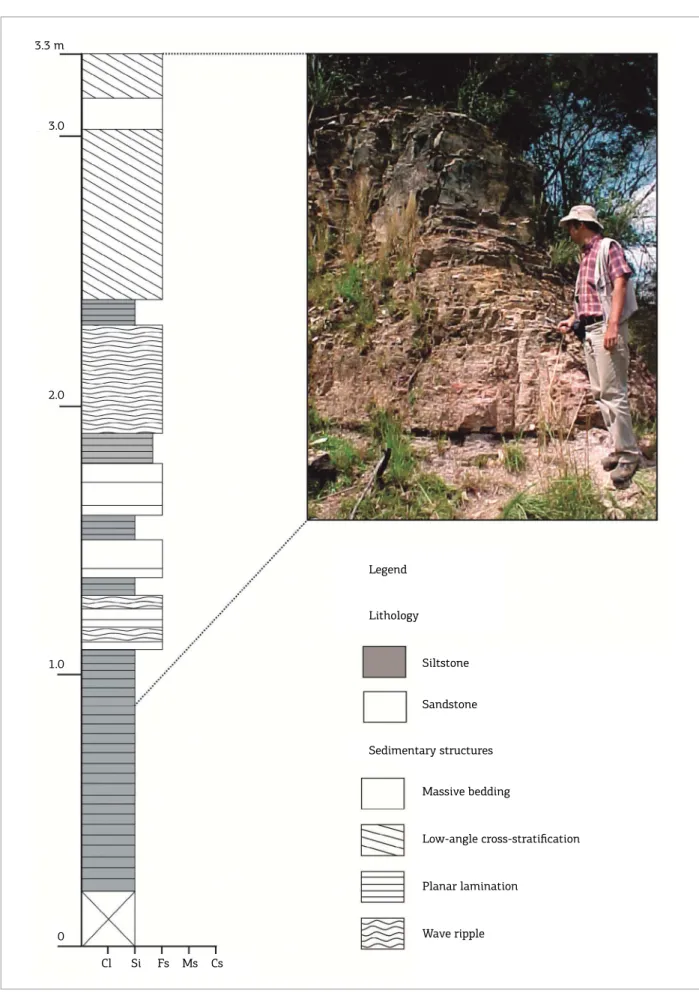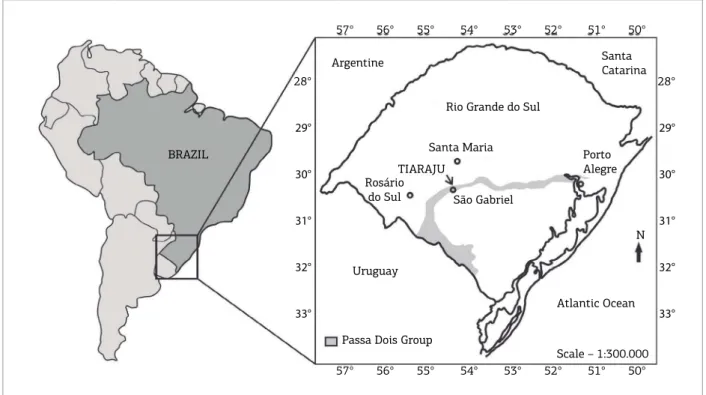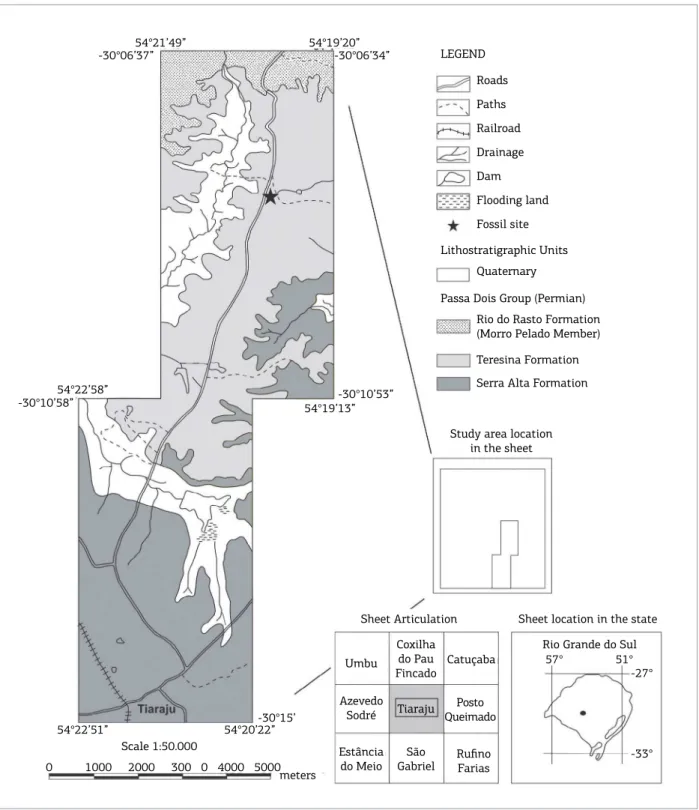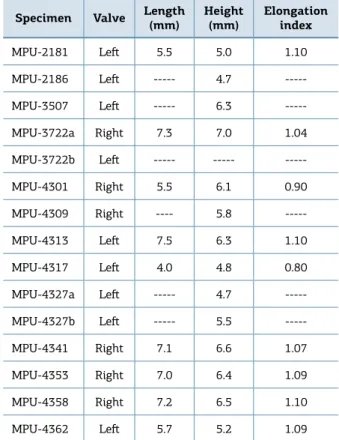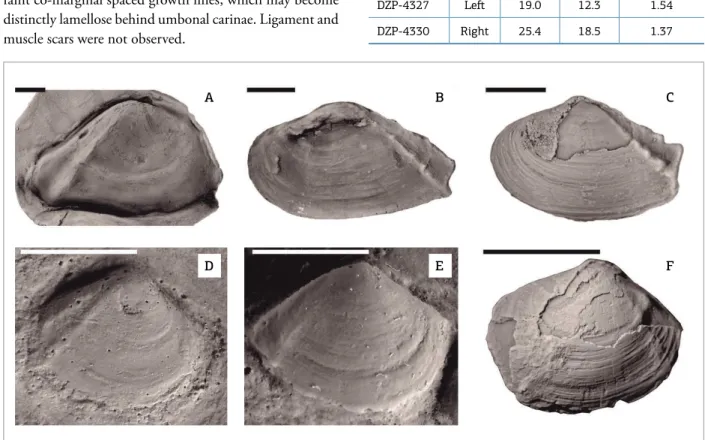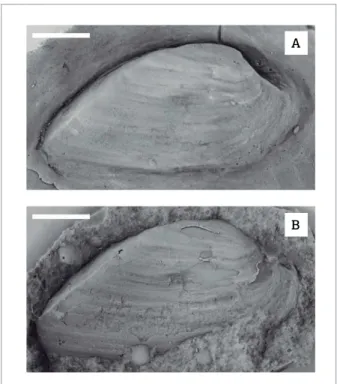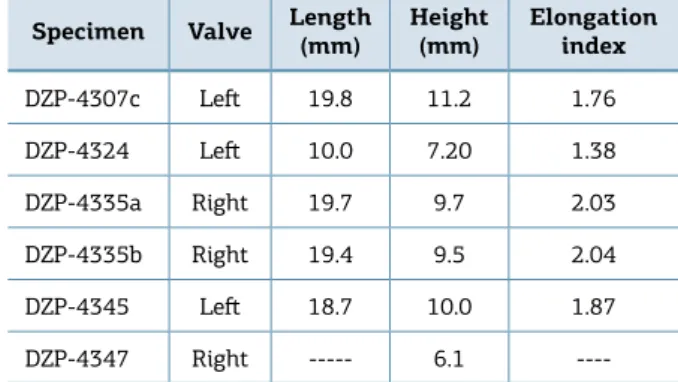1Instituto de Biociências, Universidade Estadual Paulista, Distrito de Rubião Junior, Botucatu, SP, Brazil. E-mails: profmgsimoes@gmail.com, sumatos.s@gmail.com 2Instituto de Geociências, Universidade de São Paulo, SP, Brazil. E-mails: julianamdavid@gmail.com.br, anelli@usp.br
3Companhia de Pesquisas de Recursos Minerais – CPRM, Superintendência Regional de Porto Alegre, Porto Alegre, RS, Brazil. E-mail: carla.klein@cprm.gov.br 4Instituto de Geociências e Ciências Exatas, Universidade Estadual Paulista, Rio Claro, SP, Brazil E-mails: vbguerrini@gmail.com, warren@rc.unesp.br
*Corresponding author.
Manuscript ID: 20170013. Received in: 01/27/2017. Approved in: 05/06/2017
ABSTRACT: Permian bivalves of the Paraná Basin evolved in a large inland sea, under conditions of extreme isolation and environmental stress. Although known since 1918, its evolutionary history is still obs‑ cure due to the incomplete and biased information on faunal com‑ position and stratigraphic distribution of various assemblages. Hence, the description of the Tiaraju assemblage, the only known bivalve oc‑ currence in the Passa Dois Group from the southernmost Brazil, adds new key information on the composition, biocorrelation and age of this unique molluscan fauna. Terraia falconeri, Cowperesia emerita, Hol‑ dhausiella elongata, and Terraia altissima were recorded and described. T. falconeri is the commonest species, followed by C. emerita, H. elon‑ gata and T. altissima. he faunule is mainly composed by Terrainae, lacking Pinzonellinae. Assemblage is, thus, poorly diversiied, both regarding the faunal composition and guild structure (only infaunal, facultatively motile, unattached, suspension feeders present). Cowpere‑ sia emerita and T. altissima strongly indicate biocorrelation with assem‑ blages of the Rio do Rasto and Gai‑As formations, Brazil and Namibia, providing an age no younger than the mid‑Permian (Wordian‑Captia‑ nian). On the light of this information, the current geological map of the Tiaraju region, São Gabriel, and the local boundary between the Teresina and Rio do Rasto formations requires reevaluation.
KEYWORDS: Passa Dois Group, Paraná Basin, Gai‑As Formation, Guadalupian.
RESUMO: Bivalves permianos da Bacia do Paraná evoluíram em um imenso mar interior, sob condições de extremo isolamento e estresse ambiental. Embora conhecidos desde 1918, a história evolutiva desses bivalves é ainda obscurecida pelo conhecimento incompleto e enviesado sobre a composição faunística e a distribuição estratigráica de várias assembleias. Portanto, a descrição da assembleia de Tiaraju, a única conhecida no Grupo Passa Dois do sul do Brasil, contribui com novas informações‑chave sobre a composição, biocorrelação e idade dessa fauna de moluscos únicos. Terraia falconeri, Cowperesia emerita, Holdhausiella elongata e Terraia altissima foram registradas e descritas. T. falconeri é a espécie mais comum, seguida por C. emerita, H. elongata e T. altissima. A fauna é maiormente composta por Terrainae, faltando os Pinzonellinae. A assembleia é, desse modo, pobremente diversiicada, no que tange à composição faunística e guildas (somente bivalves de infauna, facultativamente móveis, suspensívoros estão presentes). Cowperesia emerita e T. altissima sugerem, fortemente, biocorrelação com assembleias das formações Rio do Rasto e Gai‑As, Brasil e Namíbia, indicando idade não mais jovem que o Permiano médio (Wordiano‑Capitaniano). À luz dessas informações, o mapa geológico da região de Tiaraju, São Gabriel, e o contato local entre as formações Teresina e Rio do Rasto, requerem, ambos, reavaliação.
PALAVRAS-CHAVE: Grupo Passa Dois, Bacia do Paraná, Formação Gai‑As, Guadalupiano.
The Permian Tiaraju bivalve assemblage, Passa
Dois Group, southern Brazil: biostratigraphic
and paleobiogeographic signiicance
Assembleia de bivalves permianos de Tiaraju, Grupo Passa Dois,
sul do Brasil: signiicado bioestratigráico e paleobiogeográico
Marcello Guimarães Simões1*, Juliana Machado David2, Luiz Eduardo Anelli2, Carla Klein3, Suzana Aparecida Matos1, Vitor Bonatto Guerrini4, Lucas Veríssimo Warren4
INTRODUCTION
he Permian bivalve mollusk fauna of the Paraná Basin evolved in a shallow and large landlocked sea, under variable salinity and bottom water ventilation regimes (Runnegar & Newell 1971; Simões et al. 1998; Matos et al. 2017a, b). Members of the fauna were irst described by Holdhaus (1918) and by subsequent authors (see Simões & Fittipaldi 1987, for a literature review), but the fauna was only revised by Runnegar & Newell (1971). Since this benchmark review, most of the following studies aimed to elucidate unsolved issues related to the systematics (Simões et al. 1997, 1998, 2010; Mello 1999; Anelli et al. 2010), taphonomy (Torello & Simões 1994; Simões et al. 1996, 2000; Simões & Kowalewski 1998; Simões & Torello 2003; Neves et al. 2010, 2011), paleoecology (Ghilardi 1999; Kowalewski et al. 2000; Ghilardi & Simões 2002; Silva 2016; Matos et al. 2017a, b) and paleobiogeography (Wesselingh 2007; Simões et al. 2010; David et al. 2010) of the fauna. However, details of the evolutionary history of this unique bivalve fauna are still obscure because of the biased information on the fau‑ nal composition of various assemblages (Simões et al. 2010, 2015) (Fig. 1). In the rock succession of the Permian Passa Dois Group, bivalves are recorded in at least seven benthic assemblages including, in ascending order, the Taquaral assemblage, Irati Formation; the Anhembia froesi assemblage, Serra Alta Formation; the Pinzonella illusa and Pinzonella neotropica assemblages, Teresina and Corumbataí formations; the Terraia curvata and Leinzia similis assemblages, Serrinha Member, Rio do Rasto Formation; and the “Palaeomutela” platinensis assemblage, Morro Pelado Member, Rio do Rasto Formation (Fig. 1). However, previous studies focused on the fossil assemblages preserved in Teresina and Corumbataí formations (i.e., P. illusa and P. neotropica assemblages). Indeed, only recently the taphonomy and paleoecology of the bivalves of the Irati (Matos et al. 2017b) and Serra Alta formations were studied in detail (Bondioli et al. 2015; Silva 2016; Matos et al. 2017a). On the contrary, the assemblages of Morro Pelado Member, Rio do Rasto Formation (Rohn 1994), are still poorly studied and described (i.e., those bivalves are forgotten). Additionally, most studies are based on fossils from the eastern border of the Paraná Basin, mainly from the states of São Paulo and Paraná. In this context, the main aim of this contribution was to describe, for the irst time, the Tiaraju bivalve assemblage — i.e., informally known as the TB assemblage — (Cunha 1972; Klein 1997), the only one known from Permian rocks of the Passa Dois Group, State of Rio Grande do Sul, southernmost Brazil. his is relevant, since the assemblage can shed a new light into the regional faunal variations of the bivalves that pop‑ ulated the Paraná Basin during the Guadalupian Epoch,
Permian. Yet, it can improve our knowledge on the sys‑ tematics and biocorrelation of this unique endemic mol‑ luscan fauna. As discussed next, the accurate identiication of the Permian bivalves of Tiaraju allowed us to compare the TB assemblage with other Gondwanic faunas found in the Huab Basin, Namibia, helping to better constrain its correlation and age.
BACKGROUND
On the regional significance
of the Tiaraju bivalve assemblage
As aforementioned, the TB assemblage is the unique Permian bivalve fauna known in rocks of the Passa Dois Group from the State of Rio Grande do Sul, Brazil. Fossils belonging to this assemblage are preserved in carbonate con‑ cretions found in the upper part of a succession dominated by laminated mudstones tentatively placed in the Teresina Formation (Klein 1997; Klein & Simões 1998). his fauna was irst described by Cunha (1972), who assigned all the specimens to the endemic genus Cowperesia? sp. Later, Klein (1997) presented a tentative taxonomic list includ‑ ing the following bivalves: Pinzonellatiarajuensis (nomen nudum), Terraia altissima (Holdhaus 1918), Jacquesia elon‑ gata (Holdhaus 1918), Jacquesia sp., Pyramus? emerita (Reed 1929) and Naidopsis?sp. Despite this list, the TB assem‑ blage remains undescribed, according to the rules of the International Code of Zoological Nomenclature (ICZN).
During a re‑examination of the Permian bivalve faunas of the Passa Dois Group and coeval units from Brazil and Africa (David et al. 2010; David 2014), a close resemblance was observed between some of the Tiaraju specimens illus‑ trated by Klein (1997) and those from the Gai‑As Formation, Huab Basin, Namibia, which were described by David et al. (2010). In this context, this possible biocorrelation is worth of investigation, since the age of the Namibian fos‑ sils is well constrained based on radiometric dating (Wanke 2000; Holzförster 2002). In addition, some bivalve species in the compositional faunal list presented by Klein (1997) are not common in that interval of the Passa Dois Group succession. he fauna seems to include a mixture of taxa commonly found in assemblages of the Teresina and Rio do Rasto (Serrinha Member) formations, reinforcing its transitional character.
The nature of Teresina and
Rio do Rasto formations boundary
includes, from the base to the top, the upper Artinskian Irati Formation, the Kungurian Serra Alta Formation, the upper Kungurian‑Roadian Teresina Formation and the Capitanian‑Wuchiapingian Rio do Rasto Formation (Rohn 1994, 2007; Holz et al. 2010). According to our data (see systematic paleontology below), the TB assemblage has a transitional character, including a mixture of bivalve spe‑ cies that are recorded in benthic assemblages of the Teresina Formation, as well as typical members of the bivalve assem‑ blages of the base of the Serrinha Member, Rio do Rasto
Formation. herefore, the nature of the contact between these two units is worth mentioning here.
In the vicinities of the city of Lages and along the Rio do Rasto Hill section, Santa Catarina state, the Teresina Formation is a ~160‑m‑thick (Warren 2006) monotonous sedimentary succession formed by massive and laminated siltstones, interbedded with rare thin sandstone layers. Ellipsoidal‑ to discoidal‑shaped carbonate concretions occur throughout the unit. On the other hand, the Serrinha Member encompasses the lower part of the Rio do Rasto
offshore anoxic/dysoxic carbonatic/siliciclastic
CHRONO
PERMIAN
CISURALIAN
GU
AD
ALUPIAN
LOPINGIAN
ARTNSKIAN
KUNGURIAN
RO
ADIAN
W
ORDIAN
CAPIT
ANIAN
WUCHIAPINGIAN
LITHOSTRATIGRAPHY
GROUP
PASSA DOIS
FORMATION
RIO DO RASTO
TERESINA
SERRA ALTA
IRATI
MEMBER
MORRO PELADO
SERRINHA
ASSISTÊNCIA
TAQUARAL
BIVALVE ASSEMBLAGES
"Palaeomutela" platinensis
Leinzia similis Terraia curvata
Pinzonella neotropica
Pinzonella illusa
A. froesi
Taquaral Assemblage
DEPOSITIONAL SYSTEMS
FLUVIAL, DELTAIC AND EOLIC SYSTEMS
CONFINED INTERIOR SEA
ENVIRONMENTAL CONDITIONS
fresh water
oxic
siliciclastic
marginal fresh water
oxic
mainly siliciclastic
nearshore variable salinity
oxic
siliciclastic/ carbonatic
offshore dysoxic/anoxic
siliciclastic
Figure 1. Schematic chart of the Passa Dois Group, Permian, showing the vertical distribution of the bivalve assemblages in the eastern margin of the Paraná Basin, Brazil (based on Rohn 1994, 2007). Presence of Cowperesia
emerita and Terraia altissima, the absence of pinzonellids and the profuse occurrence of terraids strongly suggest
Formation and is well exposed in the outcrop belt of the Passa Dois Group, in the State of Santa Catarina, south‑ ern Brazil. he unit comprises a ~100‑m‑thick sedimen‑ tary succession with progradational architecture. his is marked, from the base to the top, by gradual changes of thick siltstone and heterolithic facies, by tabular, ine sandstone beds with swaley, hummocky and wave ripples. Plant remains of Glossopteris Flora, phosphatized teeth and ish scales, as well as highly bioturbated beds with Diploclaterion, Arenicolites and Palaeophycus icnites, are also common. hese evidences indicate that the deposi‑ tion of this interval of the Passa Dois Group succession occurred under shallow and oxic waters (Warren 2006; Warren et al. 2008).
he contact between the upper Teresina and lower Rio do Rasto formations (Serrinha Member) is transitional (Vieira 1973; Riccomini et al. 1984; Warren et al. 2008) and marked by the gradual change from siltstones to ine sandstone facies. he transition between these units is par‑ ticularly well‑marked by sandstone layers that increase in frequency and thickness from the upper Teresina Formation to the lower part of the Rio do Rasto Formation (Serrinha Member). hese reinforce the progradational pattern of the unit (Fig. 2). he lithostratigraphic contact between both units is marked by the irst occurrence of a meter‑scale, tab‑ ular bed of ine sandstone (Warren et al. 2008).
Despite the transitional contact between Teresina and Rio do Rasto formations in the State of Santa Catarina, at the borders of the Paraná Basin, that contact can be locally abrupt (Lavina 1991). Available seismic lines and wells drilled by the Brazilian Geological Survey (CPRM) in the 1980’s indicate that the contact between these two units is marked by a truncation in seismic relectors and a sudden increase in the gamma ray values. However, these are probably related to changes in facies association rather than the presence of an erosional discordance (Lavina 1991). Yet, changes in the paleontological content also indicate the occurrence of local diastemas, as evidenced by the sudden disappearance of typical members of the endemic Pinzonella fauna, and the appearance of a diverse fauna dominated by bivalves belonging to Terraia (Lavina 1991; Simões et al. 2015). his is exactly what we can see from the studied fossil material.
GENERAL GEOLOGICAL SETTING
Studied Permian bivalve‑rich rocks of the Passa Dois Group were recorded in outcrops located in the State of Rio Grande do Sul, São Gabriel District, ~300 km far from Porto Alegre (state capital), southern Brazil. he main
fossil‑rich outcrop (Figs. 3 and 4) can be reached through the unpaved road between Tiaraju and Pau Fincado locali‑ ties, ~3 km northward from the Sepé Tiaraju Monument, in the Otávio Vargas Farm. he area was originally mapped by Lavina et al. (1983) and Klein (1997), and the main geolog‑ ical data are summarized in Klein et al. (1999). According to these authors, rocks of Serra Alta, Teresina and Rio do Rasto formations, locally encompassing a 200‑m‑thick sed‑ imentary succession, are present in the area. he main sed‑ imentary facies recorded in the Tiaraju area are, from the base to the top: laminated, dark gray siltstones with dis‑ coidal carbonate concretions and clastic dikes (Serra Alta Formation); heterolytic sediments (siltstones, ine to very ine sandstones) with wavy‑linsen bedding; ine sandstones with hummocky cross‑stratiication with ish remains and intraclasts; laminated siltstones with bivalve‑rich carbon‑ ate concretions at the top (Teresina Formation); sandstones with planar cross‑stratiication; and reddish, tabular mud‑ stones (Rio do Rasto Formation) (Klein 1997; Klein et al. 1999) (Figs. 4 and 5). he contact between the laminated siltstones (Teresina Formation) and the sandstones with pla‑ nar cross‑stratiication (Rio do Rasto Formation) is sharp (Klein et al. 1999).
he laminated siltstones with discoidal carbonate con‑ cretions were deposited below storm‑wave base in ofshore settings whereas shallower dysoxic to oxic conditions were indicated by the heterolytic facies. Fine sandstones with hummocky cross‑stratiication are a record of high energy events (i.e., storms). he laminated mudstones with fos‑ sil‑rich carbonate concretions that succeed the storm sand‑ stones indicate quiet waters and the return of the day‑by‑day sedimentation. hese are abruptly (discordantly) succeeded by the sandstones deposited in eolian conditions, represent‑ ing the migration of dune ields on the water body (Klein et al. 1999). Reddish, tabular mudstones, sometimes with amphibian remains, intercalated to the sandy facies, indi‑ cate deposition under quiet, oxic, continental waters (Klein et al. 1999) (Fig. 5).
MATERIAL AND METHODS
Fossil collection and
laboratory procedures
Massive bedding
Low-angle cross-stratification
Planar lamination
Wave ripple 3.3 m
3.0
2.0
1.0
0
Cl Si Fs Ms Cs
Legend
Lithology
Siltstone
Sandstone
Sedimentary structures
partially removed from the matrix). These are repre‑ sented both by shells and molds (internal and external ones). Additionally, we also investigated twenty‑nine latex molds that were housed in the scientific collection of the Zoology Department, São Paulo State University, Botucatu Campus, under the code DZP. Preparation of the material included plasticine casts (FIMO brand) and impregnation with magnesium to enhance internal anatomical characters, including possible muscle scars, teeth and sockets (Anelli 1999).
Systematic decisions
and ecological guilds
Bivalve species recorded in the Tiaraju assemblage are described in the next section. he suprageneric sys‑ tematics was based on Morris et al. (1991) and Carter et al. (2011). he morphological terminology and sys‑ tematic classiication of pachydomids (megadesmids in previous works) were based on Mendes (1952), Runnegar & Newell (1971), Runnegar (1974) and Simões et al. (1997). he index of elongation and obesity was inter‑ preted following Stanley (1970). he ecological guilds (i.e., inferred bivalve lifestyle) were determined according to Aberhan & Kiessling (2015, p. 2), including: shallow infaunal, facultatively motile, unattached, suspension feeders (SIFMUSF) and intermediate infaunal, faculta‑ tively motile, unattached, suspension feeders (IIFMUSF).
SYSTEMATIC PALEONTOLOGY
Infraclass HETEROCONCHIA (Hertwig 1895) Cohort CARDIOMORPHI (Férussac 1822) Subcohort CARDITIONI (Dall 1889) Order CARDITIDA (Dall 1889)
Superfamily CRASSATELLOIDEA (Férussac 1822) Family incertae sedis
Terraia (Cox 1934)
Type species: Terraia altissima (Holdhaus 1918). Terraia falconeri (Cox 1934) (Figs. 6A‑F)
Type species: Pseudocorbula falconeri (Cox, 1934). Examined material: Twelve shells (MPU‑ 2181, 2186, 3507, 3722, 4301, 4309, 4313, 4327a, 4327b, 4341, 4353, 4358) and three internal molds (MPU‑ 3722, 4317, 4362).
Locality and unit: Tiaraju, Rio Grande do Sul, Passa Dois Group, Teresina Formation, Paraná Basin.
Age: Permian, Guadalupian.
Description: Small, subtriangular, equivalved, equi‑ lateral, equant to moderately elongated shell (Table 1). One posterior umbonal carinae is present, extending from the umbonal region to the postero‑ventral angle. Parallel to the umbonal carinae, a second carina faintly marked can be observed. Umbones rounded, beaks prosogyrous; well‑deined and long escutcheon and lunule, with escutch‑ eon extending entirely through the posterior dorsal mar‑ gin of the shell. Posterior dorsal margin straight to slightly
Scale – 1:300.000 BRAZIL
28°
29°
30°
31°
32°
33°
28°
29°
30°
31°
32°
33°
57° 56° 55° 54° 53° 52° 51° 50°
57° 56° 55° 54° 53° 52° 51° 50°
Argentine Santa
Catarina
Rio Grande do Sul
Santa Maria Porto
Alegre TIARAJU
Rosário
do Sul São Gabriel
Uruguay
Atlantic Ocean N
Passa Dois Group
concave; posterior extremity truncated, deining a short and straight respiratory margin; ventral margin rounded; slightly convex anterior dorsal margin. External surface of the shell covered by commarginal growth lines and largely spaced narrow rugae. Hinge plate of the left valve with thick posterior and anterior lateral margins, both ending below umbones as a slightly elevated bump separated by a
well‑deined and deep triangular socket located immedi‑ ately below beak. Muscles scars and hinge features of right valve were not observed.
Discussion: he material here described as Terraia fal‑ coneri was irst interpreted by Cunha (1972), as Pinzonella tiarajuensis (nomen nudum) (Klein 1997). he shells are externally similar to that of Pinzonella illusa, as illustrated
-33° 54°21’49”
-30°06’37” 54°19’20”-30°06’34”
54°22’58”
-30°10’58” 54°19’13”-30°10’53”
54°22’51” 54°20’22”-30°15’
Scale 1:50.000
LEGEND
Roads
Paths
Railroad
Drainage
Dam
Flooding land
Fossil site
Lithostratigraphic Units Quaternary
Passa Dois Group (Permian) Rio do Rasto Formation (Morro Pelado Member)
Teresina Formation
Serra Alta Formation
Study area location in the sheet
Sheet Articulation Sheet location in the state
Umbu
Coxilha do Pau
Fincado Catuçaba
Azevedo
Sodré Tiaraju QueimadoPosto
Estância
do Meio GabrielSão RufinoFarias
Rio Grande do Sul
57° 51°
-27°
0 1000 2000 300 0 4000 5000 meters
Figure 4. Geological map of the Tiaraju region, São Gabriel District, southern Brazil. The fossil site is highlighted
Bivalves
Serra Alta F
ormation
Teresina F
ormation
Rio do Rasto F
ormation
Unit
40m 80m 120m 160m 200m
Cl Si Fs
Legend
Clay
Siltstone
Sandstone
Sedimentary Structures Lithology
Massive bedding
Low-angle cross-stratification
Planar lamination
Wave ripple
Wavy-linsen bedding
Hummocky cross-stratification
Fluidization structure
Other Structures
Fossils
Carbonate concretions
Clastic dikes
Figure 5. Composite stratigraphic section of the Passa Dois Group, measured at the Tiaraju region. The stratigraphic
lun esc
A
D
B
E
C
F
Figure 6. Terraia falconeri (Cox, 1934), Tiaraju, Rio Grande do Sul state, Passa Dois Group, Paraná Basin, Brazil.
A-B, External view of let valve (MPU 4327a; MPU 4313. C, Internal mold of right valve, MPU 4358; D, Plaster cast of articulated valves, DZP-4337; E, Plaster cast showing the hinge features of let valve, MPU 4362d; F, Cast showing the hinge features of let valve, MPU, 4362b. Explanation: lun= lunule; esc= escutcheon. Scale bars=1mm. by Runnegar & Newell (1971, Figs. 19B, H, J). Indeed,
both shells share a triangular shape, a slightly marked umbonal carinae, and have their external surface orna‑ mented by irregular spaced growth lines. However, in the Tiaraju specimens, the hinge plate of the left valve is not sturdy developed (i.e., thick) and the cardinal and lateral teeth are virtually absent. Additionally, a posterior socket present in the hinge of Pinzonellaillusa shells is also absent. Hence, these characters and the presence of a well‑deined lunule in the Tiaraju specimens (both P. illusa and P. neo‑ tropica show a poorly deined lunule) indicate that these are not related to Pinzonella. On the other hand, it is note‑ worthy that the hinge plate of the left valve of the exam‑ ined specimens close resembles that of Terraia falconeri, as described in Beurlen (1953). Both are characterized by a thickening of the posterior and anterior lateral margins, that ends below umbones, as a slightly elevated bump sep‑ arated by a well‑deined and deep triangular socket located immediately below beak. Also, the external characters of the shells of Tiaraju specimens close resemble Terraiafal‑ coneri (Beurlen 1953), including the: general valve mor‑ phology; prosogyral beaks and presence of a second faintly marked carinae. Based on these characters the specimens are referred to Terraia falconeri.
Table 1. Measurements of Terraia falconeri.
Specimen Valve Length (mm)
Height
(mm)
Elongation index
MPU-2181 Let 5.5 5.0 1.10
MPU-2186 Let --- 4.7
---MPU-3507 Let --- 6.3
---MPU-3722a Right 7.3 7.0 1.04
MPU-3722b Let --- ---
---MPU-4301 Right 5.5 6.1 0.90
MPU-4309 Right ---- 5.8
---MPU-4313 Let 7.5 6.3 1.10
MPU-4317 Let 4.0 4.8 0.80
MPU-4327a Let --- 4.7
---MPU-4327b Let --- 5.5
---MPU-4341 Right 7.1 6.6 1.07
MPU-4353 Right 7.0 6.4 1.09
MPU-4358 Right 7.2 6.5 1.10
Terraia altissima (Holdhaus 1918) (Figs. 7A‑C) Type species: Solenomorpha altissima (Holdhaus 1918). Examined material: Two internal molds (DZP‑ 4327, 4330). Locality and unit: Tiaraju, Rio Grande do Sul, Passa Dois Group, Teresina Formation, Paraná Basin.
Age: Permian, Guadalupian.
Description: Small, equivalved, inequilateral, moderately elongated to elongated shell (Table 2). Two well‑deined pos‑ terior umbonal carinae extend from umbonal region to the postero‑dorsal and postero‑ventral angles; the ventral carinae bears around seven visible protuberances (knobs). he knobs are faintly visible in the internal mold. he ventral carinae is more pronounced than the dorsal one, which borders the escutcheon ventrally. Umbones low. Anterior dorsal margin slightly convex; anterior margin rounded; posterior margin straight, angular where intercepted by the two posterior carinae. Hinge of right valve partially preserved, showing a well‑deined triangular cardinal tooth; anterior and poste‑ rior dorsal margins of right valve bordered ventrally by an elongated lateral tooth; immediately above, an elongated socket is present, possibly for receiving the anterior and posterior dorsal edges of left valve. External ornament of faint co‑marginal spaced growth lines, which may become distinctly lamellose behind umbonal carinae. Ligament and muscle scars were not observed.
Discussion: he genus Terraia has been described from several Permian rocks in Brazil and Uruguay, and more recently in Namibia (David et al. 2010; David 2014). he specimens from the TB assemblage bear most of the characters (i.e., absence of lunule, triangular cardinal tooth in right valve, an obscure lateral teeth and socket) present in Terraia altis‑ sima. In addition, the specimens here described also show most of the diagnostic features listed by Runnegar & Newell (1971), including the: double umbonal carinae; presence of escutcheon; and absence of lunule. Yet, Terraia cf. T. altis‑ sima from the Gai‑As Formation, Namibia (David et al. 2010), is very similar to the shells described here, regard‑ ing its external morphology, including the presence of two well‑deined posterior umbonal carinae, an external lamel‑ lose commarginal shell ornamentation, and low umbones.
Infraclass HETEROCONCHIA (Hertwig 1895) Megaorder SOLENATA (Dall 1889)
Order HIATELLIDA (Carter et al. 2011)
A
D
C
F B
E
Figure 7. Terraia altissima (Holdhaus, 1918) and Cowperesia emerita (Reed,1929), Tiaraju, Rio Grande do Sul state, Passa Dois Group, Paraná Basin, Brazil. A-C, Terraia altissima. A, Plaster cast of right valve, showing the triangular
cardinal tooth, DZP-4330; B, Plaster cast of let valve, DZP-4327. C, Terraia sp. cf. Terraia altissima (Holdhaus,
1918), Gai-As Formation, Huab area, Permian, Namibia. External view of siliciied let valve, DZP-18711.
D-F, Cowperesia emerita. D, External view of right valve, MPU 4363. E, Plaster cast of right valve, DZP-4323. F, Cowperesia emerita (Reed, 1929), Gai-As Formation, Huab area, Permian, Namibia. Incomplete internal mold of
let valve with siliciied shell remains, DZP-18700. Scale bars=5mm.
Table 2. Measurements of Terraia altissima.
Specimen Valve Length (mm)
Height
(mm)
Elongation index
DZP-4327 Let 19.0 12.3 1.54
Superfamily EDMONDIOIDEA (King 1850) Family PACHYDOMIDAE (Fischer 1887) Subfamily PACHYDOMINAE (Fischer 1887) Tribe PLESIOCYPRINELLINI (Simões et al. 1997) Cowperesia emerita (Reed 1929) (Figs. 7D and 7E) Type species: Pseudocorbula emerita (Reed 1929). Examined material: Four shells (MPU‑ 4340, 4363, 4595, 5704) and two internal molds (MPU‑ 4316, 4452; DZP‑4323).
Locality and unit: Tiaraju, Rio Grande do Sul, Passa Dois Group, Teresina Formation, Paraná Basin.
Age: Permian, Guadalupian.
Description: Small, subtriangular, equivalved, equilat‑ eral, equant to moderately elongated shell (Table 3). Two well deined and slightly curved posterior umbonal carinae are present, one extending from the umbonal region to the pos‑ tero‑ventral angle and the other close to the postero‑dorsal margin. Very weak projections are evident where co‑mar‑ ginal growth lines cross the umbonal carinae. Anterior dorsal margin straight; anterior margin rounded; posterior margin straight. External ornament of ine, commarginal growth lines, superimposed by widely spaced, broad co‑marginal rugae, also apparent on internal molds. Hinge features and musculature unknown.
Discussion: he shells from Tiaraju close resemble those described by David et al. (2010) as Cowperesia emerita from the Gai‑As Formation, Huab area, Namibia. Indeed, the external shell characters are very similar, including the: orna‑ mentation; presence of double umbonal carinae; and gen‑ eral shell shape. Yet, it close resembles the specimens of Cowperesiaemerita found in the Serrinha Member, Rio do Rasto Formation as well (Simões et al. 2015, p. 21, Fig. 5).
Holdhausiella (Mendes 1952)
Type species: Holdhausiella elongata (Holdhaus 1918). Discussion: Runnegar & Newel (1971) considered Holdhausiella as junior synonyms of Jacquesia Mendes. After this, four species were recognized as belonging
to the genus Jacquesia: Jacquesia brasiliensis Reed 1929, Jacquesiaarcuata (=Favalia arcuata Mendes 1962), Jacquesia elongata [=Holdhausiellaelongata (Holdhaus 1918)] and Jacquesiaalmeidai (=Holdhausiellaalmeidai Mendes 1952). However, Mello (1999) carried out a cladistic analysis and showed that the synonym proposed by Runnegar & Newell (1971) is not valid. Since they are, indeed, very distinct from the type of material of Jacquesia, here we follow Mello’s interpretation.
Holdhausiella elongata (Holdhaus 1918) (Figs. 8A and 8B) Type species: Sanguinolites elongates (Holdhaus 1918). Examined material: Seven internal molds (DZP‑4307c, 4324, 4345, 4366, 4335a, b, 4347).
Locality and unit: Tiaraju, Rio Grande do Sul, Passa Dois Group, Teresina Formation, Paraná Basin.
Age: Permian, Guadalupian.
Description: Small to medium‑sized, equivalved, inequi‑ lateral, elongated to very elongated shell (Table 4), posteri‑ orly expanded, with shallow lateral sulcus and slightly arched carinate umbonal ridge. Umbones low, beaks prosogyrates; posterior umbonal slope slightly concave as seen in internal molds; anterior dorsal margin short and slightly concave; anterior extremity rounded; ventral margin nearly straight; posterior dorsal margin straight. External surface with faint commarginal irregularly spaced rugae. Hinge features and muscle scars not observed.
Table 3. Measurements of Cowperesiaemerita.
Specimen Valve Length (mm)
Height
(mm)
Elongation index
MPU-4316 Let --- 5.1
---MPU-4340 Right 7.2 ---
---MPU-4363 Right 6.1 5.0 1.22
MPU-4452 --- --- ---
---MPU-4595 Let 5.5 4.7 1.17
MPU-5704 Right 4.7 ---
---DZP-4323 Right 5.4 4.4 1.22
Figure 8. Holdhausiella elongata (Holdhaus, 1918), Tiaraju,
Rio Grande do Sul state, Passa Dois Group, Paraná Basin,
Brazil. A, Latex cast of right valve, DZP-4335a; B, Plaster cast of right valve, DZP-4335b. Scale bars=5mm.
A
Discussion: he specimen from Tiaraju is very similar in shell shape and external characters to Houldhausiella elongata, described and illustrated in Runnegar & Newell (1971, Figs. 16A‑J), includ‑ ing the: posterior expanded shell; umbonal carinae; rounded, anterior portion of shell margin; and external surface ornamented by faint commarginal, irregularly spaced, rugae.
RESULTS AND DISCUSSION
Assemblage composition and taphonomy
he Tiaraju assemblage is poorly diversiied, both regarding the taxonomic composition and ecological guilds (Tables 5 and 6). However, caution must be taken due to the small sample size (Tables 5 and 6). he identiied bivalves are here
Table 5. Taxonomic composition and paleoecology of the Tiaraju bivalve assemblage, southern Brazil.
Superfamily Species Guilds n.
Crassatelloidea Terraia falconeri SIFMUSF 15
Terraia altissima SIFMUSF 2
Edmondioidea
Cowperesia emerita IIFMUSF 7
Holdhausiella elongata SIFMUSF 7
Totals 31
SIFMUSF: shallow infaunal, facultatively motile, unattached, suspension feeders; IIFMUSF: intermediate infaunal, facultatively motile, unattached, suspension feeders.
Table 6. Guild composition of the Tiaraju bivalve assemblage, southern Brazil.
Assemblage Bivalve guilds n.
Tiaraju SIFMUSF 24
IIFMUSF 7
Totals 31
SIFMUSF: shallow infaunal, facultatively motile, unattached, suspension feeders; IIFMUSF: intermediate infaunal, facultatively motile, unattached, suspension feeders.
referred to the following species: Terraia falconeri; Cowperesia emerita; Holdhausiella elongata, and Terraia altissima (Table 5). Holdhausiella elongata is restrict to the Brazilian portion of the Paraná Basin, but Cowperesia emerita, Terraia altissima, and Terraia falconeri are also recorded in other coeval basins of the Central Gondwanic Realm (González 1989). Among the identiiable species, Terraia falconeri is the most abundant one, and is followed by Cowperesia emerita and Holdhausiella elongata (Table 5). herefore, the Terrainae bivalves are the commonest, lacking the typical members of the preceding assemblages of the Teresina/Corumbataí formations (i.e., Pinzonellinae and Pachydomidae), particularly Pinzonella and Plesiocyprinella.
According to Klein (1997) and Klein & Simões (1998), which detailed studied the taphonomy of the Tiaraju assem‑ blage, the good preservational quality of the shells and the frequent occurrence of articulated ones indicate that the shells were not exposed to long periods in the sediment‑water inter‑ face. However, some rare shells were submitted to distinct fossilization processes and were mixed with other non‑coeval bioclasts (Klein & Simões 1998). Indeed, the shell inilling in some articulated shells is distinct (sparitic) of the sedimentary matrix (micritic), implying in some degree of time‑averaging and shell mixing (Klein & Simões 1998). In summary, the Tiaraju assemblage is a time‑averaged, parautochthonous‑al‑ lochthonous assemblage (Kidwell et al. 1986).
Affinities and age
Faunal composition of Tiaraju assemblage, as described above, indicates a mixture of bivalve species that are both found in the Teresina Formation and the overlaying Rio do Rasto Formation. Indeed, Cowperesia emerita and Terraia altissima are two species that are commonly found in bivalve assemblages recorded in the basal part of the Rio do Rasto Formation (Serrinha Member) (Simões et al. 2015), whereas Terraia falconeri is only known in assemblages of the upper part of Teresina Formation (Pinzonella neotrop‑ ica assemblage) from Brazil (Beurlen 1953) and Uruguay (Cox 1934). However, the absence of pinzonellids and the profuse occurrence of terraids is a strong indication of faunal ainities with those assemblages of the basal part of the Rio do Rasto Formation. Cowperesia emerita and Terraia altissima are also recorded in the bivalve assemblages of the Gai‑As Formation, Huab area, Namibia (David et al. 2010), where they are also associated to Huabiella compressa and Terraia sp. cf. T. curvata. Correlation of the Gai‑As bivalve assemblage is well constrained with those of the basal part of the Serrinha Member (Rio do Rasto Formation) (David et al. 2010). Hence, despite the absence of deposits the Serrinha Member, basal part of Rio do Rasto Formation, in the geological map of the
Table 4. Measurements of Holdhausiella elongata.
Specimen Valve Length (mm)
Height
(mm)
Elongation index
DZP-4307c Let 19.8 11.2 1.76
DZP-4324 Let 10.0 7.20 1.38
DZP-4335a Right 19.7 9.7 2.03
DZP-4335b Right 19.4 9.5 2.04
DZP-4345 Let 18.7 10.0 1.87
----Tiaraju region, the bivalve fauna suggests a correlation to those of the basal part of the Serrinha interval of the Passa Dois Group. Yet, in the Permian deposits of the Gai‑As Formation, where Cowperesia emerita and Terraia altissima are common, radiometric dating of zircon grains from tuf beds found in the bivalve‑bearing succession provided U/Pb ages of 265 ± 2.5 Ma (Wanke 2000; Holzförster 2002). herefore, a Wordian‑Capitanian age is indicated to the bivalve fauna (David et al. 2010). In other words, the TB assemblage deposits could represent an age no younger than the (Guadalupian) Epoch.
Paleobiogeography
he current knowledge about the paleobiogeographic distribution of the Passa Dois Group bivalve species involves occurrences in Brazil (Reed 1929; Mendes 1954; Mezzalira 1957; Maranhão 1986; Rohn 1994), Uruguay (Cox 1934; Morton & Herbst 1990), Paraguay (Reed 1935), Namibia (David et al. 2010) and South Africa (Cooper & Kensley 1984). In Brazil, the related occur‑ rences are distributed in the states of São Paulo, Paraná, Santa Catarina and Mato Grosso. he Tiaraju bivalve fauna represents the only known Permian assemblage doc‑ umented in the Passa Dois Group succession of the State of Rio Grande Sul, adding evidence that during certain times in the geological history of Paraná Basin the bivalve species were not geographically restricted to certain areas (also Simões et al. 2010).
he mechanisms involved in the bivalve distribution during the deposition of the Passa Dois Group were dis‑ cussed by Simões et al. (2010). hese authors argued that a possible association could exist between bivalve radia‑ tion and water level luctuations, since the widest distri‑ bution of some species are usually associated to depos‑ its recording looding episodes (“transgressions”). On the contrary, faunal isolation correlates with intervals of water level falls (“regressions”). Basin level luctuations have been recognized with benthic faunal diversity luc‑ tuations and variations in spatial distribution through the Phanerozoic (Newell 1967; Simberlof 1974; Flessa & Sepkoski 1978; Bayer & McGhee 1985; Dockery 1986; Jablonski & Flessa 1986; Hallam 1987, 1992; Brett & Baird 1995; Brett 1998).
In the stratigraphic succession of the Passa Dois Group in the Tiaraju region, the bivalve‑rich interval, which is asso‑ ciated to laminated mudstones, records the last “transgres‑ sive” event of this unit, which may favor faunal dispersion. In this context, the TB assemblage is a regional example of the poorly diversiied benthic assemblages, which pop‑ ulated distinct parts of the Paraná landlocked sea, during the Guadalupian.
CONCLUSIONS
Here we added new and key evidences regarding the nature and faunal composition of the endemic molluscan fauna that thrived in a large, landlocked sea during the Guadalupian. he Tiaraju bivalve assemblage includes the following species Terraia falconeri, Cowperesiaemerita, Holdhausiellaelongata, and Terraiaaltissima, which were preserved in transgressive deposits previously attributed to the upper part of Teresina Formation. he TB assem‑ blage is poorly diversiied, both regarding the taxonomic composition and ecological guilds, suggesting that the bivalves lourished under conditions of high environmental stress. he assemblage includes a mixture of elements that were previously recorded in Teresina Formation, as well as in the basal part of Rio do Rasto Formation, Serrinha Member, showing the transitional character of the fau‑ nule. he identiied bivalves are also key elements to bio‑ correlation, constraining the TB assemblage with those of the Gai‑As Formation, Huab area, Namibia (David et al. 2010), indicating an age no younger than 265 ± 2.5 Ma (Wordian‑Captianian).
CLOSING THOUGHTS
Data presented above indicate that the Tiaraju bivalve fauna is a transitional assemblage between those at the topmost part of the Teresina Formation and at the low‑ ermost part of the Rio do Rasto Formation. herefore, the absence of lithotypes of the Serrinha Member, Rio do Rasto Formation, in the available regional geological maps is puzzling. Given the transitional character of the fauna, future regional geological studies of the Passa Dois Group deposits in the Tiaraju area, São Grabriel District, State of Rio Grande do Sul, should be viewed under this condition. Hence, the currently accepted geological maps and the boundary between Teresina and Rio do Rasto for‑ mations in this area require reevaluation on the light of the paleontological information.
ACKNOWLEDGEMENTS
Aberhan, M., Kiessling, W. 2015. Persistent ecological shits in marine molluscan assemblages across the end-Cretaceous mass extinction. In: Proceedings of the National Academy of Sciences, p. 1–6. Early Edition.
Anelli L.E. 1999. Invertebrados neocarboníferos das formações Piauí (Bacia do Parnaíba) e Itaituba (Bacia do Amazonas): taxonomia; análise cladística das subfamílias Oriocrassatellinae (Crassatellacea, Bivalvia) e Neospiriferinae (Spiriferoidea, Brachiopoda). PhD. Thesis, Universidade de São Paulo, São Paulo, 184 p.
Anelli L.E., Simões M.G., David J.M. 2010. A new Permian bivalve (Megadesmidae, Plesiocyprinellinae) from the Serrinha Member, Rio Do Rasto Formation, Paraná Basin, Brazil. Revista do IG, 10:13–21.
Bayer U. & McGhee G.R. 1985. Evolution in marginal epicontinental basins: The role of phylogenetic and ecologic factors (Ammonite replacements in the German Lower and Middle Jurassic). In: Bayer U. & Seilacher A. (eds). Sedimentary and evolutionary cycles, New York, Springer, p. 164–220.
Beurlen K.K. 1953. Considerações sobre alguns lamelibrânquios das camadas Terezina no Paraná. Boletim da divisão de geologia e mineralogia, 142:7–40.
Bondioli J.G., Matos S.A., Warren L.V., Assine M.L., Riccomini C., Simões M.G. 2015. The interplay between event and background sedimentation and the origin of fossil-rich carbonate concretions: a case study in Permian rocks of the Paraná Basin, Brazil. Lethaia, 48:522–539.
Brett C.E. 1998. Sequence stratigraphy, paleoecology, and evolution: biotic clues and responses to sea level luctuations. Palaios,
13:241–262.
Brett C.E., Baird G.C. 1995. Coordinated stasis and evolutionary ecology of Silurian to Middle Devonian faunas in the Appalachian Basin. In: Erwin D. H. & Anstey R. L. (eds). New approaches to speciation in the fossil record. New York, Columbia University Press, p. 285–315.
Carter J.G., Altaba C.R, Anderson L.C., Araujo R., Biakov A.S., Bogan A.E., Campbell D., Campbell M., Chen J., Cope J.C.W., Delvene G., Dijkstra H.H., Fang Z., Gardner R.N., Gavrilova V.A., Goncharova I.A., Harries P.J., Hartman J.H., Hautmann M., Hoeh W.R., Hylleberg J., Jiang B., Johnston P., Kirkendale L., Kleemann K., Koppka J., Kríz J., Machado D., Malchus N., Márquez-Aliaga A., Masse J., McRoberts C.A., Middelfart P.U., Mitchell S., Nevesskaja L.A., Özer S., Pojeta J.J., Polubotko I.V., Pons J.M., Popov S., Sánchez T., Sartori A.F., Scott R.W., Sey I.I., Signorelli J.H., Silantiev V.V., Skelton P.W., Steuber T., Waterhouse J.B., Wingard G.L., Yancey T. (eds). 2011. A
Synoptical Classiication of the Bivalvia (Mollusca). Paleontological Contributions, Number 4. Kansas, Lawrence, Publication of the University of Kansas, p. 1–47.
Cooper M.R., Kensley B. 1984. Endemic South America Permian bivalve mollusks from the Ecca of South Africa. Journal of Paleontology, 58:1360–1363.
Cox L.R. 1934. Triassic Lamellibranchia from Uruguay. Annals and
Magazine of Natural History, 13:264–273.
Cunha M.C.L. 1972. Contribuição à Paleontologia Estratigráica do
Grupo Passa Dois no Rio Grande do Sul. MS Dissertation, Universidade Federal do Rio Grande do Sul, 103 p.
Dall W.H. 1889. On the hinge of pelecypods and its development, with an attempt toward a better subdivision of the group. American Journal of Science, 38:445–462.
David J.M. 2014. Bivalves permianos do Grupo Passa Dois, Bacia do Paraná, Brasil e do Grupo Ecca, Bacia do Karoo, África do Sul: Implicações bioestratigráicas e paleoambientais. PhD. Thesis, Universidade de São Paulo, São Paulo, 165 p.
David J.M., Simões M.G., Anelli L.E., Rohn R., Holzförster F. 2010. Permian bivalve molluscs from the Gai-As Formation, northern Namibia: systematics, taphonomy and biostatigraphy. Alcheringa,
35:497–516.
Dockery D.T. 1986. Punctuated succession of Paleogene mollusks in the northern Gulf Coastal Plain. Palaios, 1:582–589.
Férussac A.E. 1822. Tableaux systématiques des animaux mollusques. Paris and London, A. Bertrand, 111 p.
Fischer P.H. 1887. Manuel de Conchyliologie et de Paleontologie Conchyliologique, ou Histoire Naturelle des Mollusques Vivants et Fossiles. Paris, F. Savy, p. 1009–1369.
Flessa K.W., Sepkoski J.J. 1978. On the relationship between Phanerozoic diversity and changes in habitable area. Paleobiology,
4:359–366.
Ghilardi R.P. 1999. Paleoautoecologia dos bivalves do Grupo Passa Dois (Neopermiano), no Estado de São Paulo: bivalves fósseis como indicadores da dinâmica sedimentar. MS Dissertation, Instituto de Geociências, Universidade de São Paulo, São Paulo, 160 p.
Ghilardi R.P., Simões M.G. 2002. Foram os bivalves do Grupo Passa Dois (exclusive Formação Rio do Rasto), Neopermiano, invertebrados tipicamente dulcícolas? Pesquisas em Geociências, 29:3–13.
González C.R. 1989. Relaciones bioestratigraicas y paleogeograicasdel Paleozoico Superior Marino en el Gondwana Sudamericano. Acta Geologica Lilloana, 1:5–20.
Hallam A. 1987. Radiations and extinctions in relation to environmental change in the marine Lower Jurassic of northwest Europe. Paleobiology, 13:152–168.
Hallam A. 1992. Phanerozoic sea level changes. New York, Columbia University Press, 266 p.
Hertwig C.W.T.R. 1895. Lehrbuch der Zoologie. Gustav Fischer, Boulder, 599 p.
Holdhaus K. 1918. Sobre alguns lamelibrânquios fósseis do sul do Brasil. Serviço Geológico e Mineralógico, 2:1–24.
Holz M., França A.B., Souza P.A., Iannuzzi R., Rohn R. 2010. A stratigraphic chart of the Late Carboniferous/Permian succession of the eastern border of the Paraná Basin, Brazil, South America. Journal of South American Earth Sciences, 29:381–399.
Holzförster F. 2002. Sedimentology, stratigraphy and synsedimentary tectonics of the Karoo Supergroup in the Huab and Waterberg-Erongo areas, N-Namibia. Beringeria, 30:1–144.
Jablonski D., Flessa K.W. 1986. The taxonomic structure of shallow-water marine faunas: implications for Phanerozoic extinctions. Malacologia, 27:43–66.
Kidwell S.M., Fürsich F.T., Aigner T. 1986. Conceptual framework for the analysis of fossil concentrations. Palaios, 1:228–238.
King W. (eds). 1850. A monograph of the Permian fossils of England. Palaeontographical Society, 378 p.
Klein C. 1997. Contribuição ao estudo das concentrações fossilíferas do Grupo Passa Dois na região de Tiaraju, RS e suas implicações paleoambientais. MS Dissertation, Universidade do Vale do Rio dos Sinos, São Leopoldo, 132 p.
Klein C., Simões M.G. 1998. Tafonomia de pelecípodes da Formação Teresina (Permiano), Tiaraju, RS, Brasil. Anais da Academia Brasileira de Ciências, v. 70, p. 617–625.
Kowalewski M., Simões M.G., Torello F.F., Mello L.H.C., Ghilardi R.P. 2000. Drill holes in shells of Permian benthic invertebrates. Journal of Paleontology, 74:532–543.
Lavina E.L. 1991. Geologia sedimentar e paleogeograia do
Neopermiano e Eotriássico (intervalo Kazaniano - Citiano) da Bacia do Paraná. PhD. Thesis, Universidade Federal do Rio Grande do Sul, Porto Alegre, 332 p.
Lavina E.L., Azevedo S.A., Barberena M.C. 1983. Geologia da Folha de Tiaraju, RS. Porto Alegre, UFRGS-FINEP. Mapa 1.
Maranhão M.S.A.S. 1986. Contribuição ao conhecimento da malacofauna das camadas basais da Formação Corumbataí (Permiano), Estado de São Paulo. MS Dissertation, Instituto de Geociências, Universidade de São Paulo, São Paulo, 88 p.
Matos S.A., Warren L.V., Fürsich, F.T., Alessandretti, A., Assine M.L., Riccomini, C., Simões, M.G. 2017a. A possible late Paleozoic seep deposit and the associated bivalve fauna from the Permian Gondwana of Brazil. Journal of South American Earth Sciences,
77: 21–41.
Matos S.A., Warren L.V., Varejão, F.G., Assine M.L., Simões, M.G. 2017b. Permian endemic bivalves of the “Irati anoxic event”, Paraná Basin, Brazil: Taphonomical, paleogeographical and evolutionary implications. Paleogeography, Paleoclimatology, Paleoecology, 469:18–33.
Mello L.H.C. 1999. Análise cladística dos bivalves do Grupo Passa Dois (Neopermiano), Bacia do Paraná, Brasil: implicações taxonômicas, evolutivas e paleobiogeográficas. MS Dissertation, Instituto de Geociências, Universidade de São Paulo, São Paulo, SP, 160 p.
Mendes J.C.M. 1952. A Formação Corumbataí na região do Rio Corumbataí. (Estratigraia e descrição dos lamelibrânquios). Boletim
da Faculdade de Filosoia, Ciências e Letras da Universidade de São
Paulo, 145, Geologia, 8:119.
Mendes J.C.M. 1954. Contribuição à estratigrafia da Série Passa Dois no Estado do Paraná. Boletim da Faculdade de Filosofia,
Ciências e Letras da Universidade de São Paulo, 175, Geologia,
10:1–119.
Mendes J.C.M. 1962. Lamelibrânquios permianos do oólito de Angatuba, Estado de São Paulo. Boletim da Sociedade Brasileira de Geologia, 11:37–56.
Mezzalira S. 1957. Ocorrências fossilíferas novas da Série Passa Dois no Estado de São Paulo. Revista do Instituo Geológico, 1:15–34.
Morris N.J., Dickins M., Astaieva‑Urbajtis K. 1991. Upper Paleozoic Anomalodesmatan Bivalve. British Museum of Natural History,
Bulletin (Geology), 47:51–100
Morton L.S., Herbst R. 1990. Leinzia similis (HOLDHAUS), (PELECYPODA) del Permico Superior (Formacion Yaguai) del Uruguay. Revista de la asociacion de Ciencias Naturales del Litoral, 21:95–97.
Neves J.P., Rohn R., Simões M.G. 2010. Tafonomia de Biválvios em Cálcários Oolíticos da Formação Teresina (Bacia do Paraná, Permiano Médio, Pudentópolis, PR). Geologia USP, Série
Científica, 10:19–36.
Neves J.P., Rohn, R., Simões M.G. 2011. Tafonomia de Tempestitos Conchíferos Amalgamados da Formação Teresina em Rio Preto (Estado do Paraná, Permiano Médio, Bacia do Paraná) e suas Implicações Paleoambientais. Geologia USP, Série Cientíica,
11:131–147.
Newell N.D. 1967. Revolutions in the history of life. In: Albritton Jr. C.C. (eds.). Uniformity and simplicity: a symposium on the principle
of the uniformity of nature. Geological Society of America Special Paper, 89:63–91.
Reed F.R.C. 1929. Faunas Triassicas do Brasil. Serviço Geológico e
Mineralógico do Brasil, 9:1–83.
Reed F.R.C. 1935. Some Triassic lamellibranchs from Brazil and Paraguay. Geological Magazine, 72:33–42.
Riccomini C., Gimenez Filho A., Almeida F.F.M. 1984. Considerações sobre a estratigraia do Permo‑Triássico na região da Serra do Cadeado, Paraná. In: SBG, Congresso Brasileiro de Geologia, 33, Rio de Janeiro, Anais, v. 2, p. 754–764.
Rohn R. 1994. Evolução ambiental da Bacia do Paraná durante o Neopermiano no leste de Santa Catarina e do Paraná. PhD Thesis, Instituto de Geociências, Universidade de São Paulo, São Paulo, 480 p.
Rohn R. 2007. The Passa Dois Group (Paraná Basin, Permian): investigations in progress. In: Workshop - Problems in the Western Gondwana Geology, South America - Africa correlations: du Toit revisited, 1, Gramado, Extended Abstracts, v. 1, p. 151–157.
Runnegar B. 1974. Evolutionary History of the Bivalve Subclasse Anomalodesmata. Jounal of Paeontology, 48:904–939.
Runnegar B., Newell N.D. 1971. Caspian- like relict moluscan fauna in the South America Permian. Bulletin of the American Museum of Natural History, 146:1–66.
Silva, S.A.M. 2016. Tafonomia e paleoecologia de bivalves permianos
em fácies siliciclásticas deicientes em oxigênio: O exemplo das
formações Irati e Serra Alta, Bacia do Paraná, Brasil. PhD. Thesis, Universidade de São Paulo, São Paulo, 183 p.
Simberlof D. 1974. Permo‑Triassic extinctions: efects of an area on biotic distributions. Journal of Geology, 82:267–274.
Simões M.G., Anelli L.E., David J.M. 2010. Othonella araguaiana (Bivalvia, Megadesmidae) from the Corumbataí Formation (Midlle Permian), eastern margin of the Paraná Basin: systematical, evolutionary and biostratigraphical signiicances. Revista do IG,
10:45–55.
Simões M.G., Fittipaldi F.C. 1987. Bivalves do Grupo Passa Dois, Permiano da Bacia do Paraná: sinopse das pesquisas. In: VI Simpósio Regional de Geologia, 6, Rio Claro, Atas, v. 1, p. 281–295.
Simões M.G., Kowalewski M. 1998. Shell beds as paleoecological puzzles: a case study from the Upper Permian of the Paraná Basin, Brazil. Facies, 38:175–196.
Simões M.G., Marques A.C., Mello L.H.C., Anelli L.E. 1997. Philogenetic analysis of the genera of the extinct family Megadesmidae (Pelecypoda, Anomalodesmata), with remarks on its paleoecology and taxonomy. Journal of Comparative Biology, 2:75–90.
Simões M.G., Matos S.A., Anelli L.E., Rohn R., Warren L.V., David J.M. 2015. A new Permian bivalve-dominated assemblage in the Rio do Rasto Formation, Paraná Basin, Brazil: faunal turnover driven by regional-scale environmental changes in a vast epeiric sea. Journal of South American Earth Sciences, 64:14–26.
Simões M.G., Rocha-Campos A.C., Anelli L.E. 1998. Paleoecology and evolution of Permian pelecypod assemblages (Paraná Basin) from Brazil. In: Johnston P.A., Haggart J.W. (eds.). Bivalves - An Eon of evolution: paleobiological studies honoring Norman D. Newell. Calgary, University of Calgary Press, p. 443–452.
Simões M.G., Torello F.F., Mello L.H.C., Ghilardi R.P. 2000. O conteúdo fossilífero de novos aloramentos do Grupo Passa Dois (Neopermiano), nas porções centro sul e nordeste do Estado de São Paulo: implicações bioestratigráicas e paleoecologicas. Acta Geologica Leopoldensia, 23:61–90.
Simões M.G., Torello F.F., Rocha-Campos A.C. 1996. Gênese e Classiicação da Coquina de Camaquã, Formação de Corumbataí (Neopermiano), na Região de Rio Claro, SP. Anais da Academia Brasileira de Ciências, v. 68, p. 545–557.
Stanley S.M. 1970. Relation of shell form to life habits of the Bivalvia (Mollusca). Memoir of the Geological Society of America, 125:1–296.
Torello F.F., Simões M.G. 1994. Características tafonômicas da assembléia de Pinzonella illusa Reed, Formação Corumbataí (Neopermiano), Bacia do Paraná, Brasil. Acta Geologica Leopoldensia, 39:159–173.
Vieira A.J. 1973. Geologia do centro e Nordeste do Paraná e Centro Sul de São Paulo. In: SBG, Congresso Brasileiro de Geologia, 27, Aracaju, Anais, v. 3, p. 259–277.
Wanke A. 2000. Karoo‑ Etendeka Uncoformites in NW Namibia
and their Tectonic Implications. PhD Thesis, Würzburg University, Alemanha, 166 p.
Warren L.V. 2006. Evolução Sedimentar Da Formação Rio Do Rasto Na Região Centro-Sul Do Estado De Santa Catarina. MS Dissertation, Universidade De São Paulo, São Paulo, 174 p.
Warren L.V., Almeida R.P., Hachiro J., Machado R., Roldan L.F., Steiner S.S., Chamani M.A.C. 2008. Evolução Sedimentar da Formação Rio Do Rasto (Permo-Triássico da Bacia do Paraná) na porção centro-sul do Estado de Santa Catarina, Brasil. Revista Brasileira de Geociências, 38:213–227.
Wesseling F.P. 2007. Long-lived lake molluscs as island faunas: a bivalve perspective. Remena W. (eds). In: Biogeography, time and place: distributions, barriers and islands. Dordrecht, Springer, p. 275–314.
